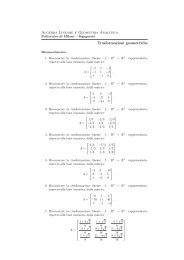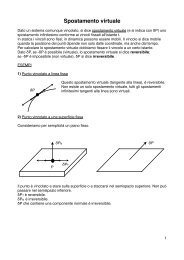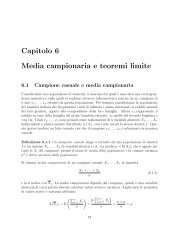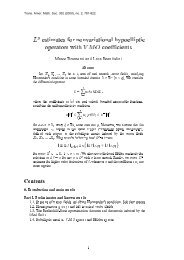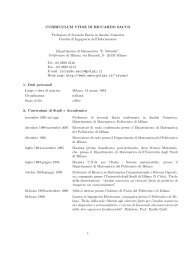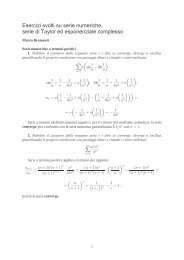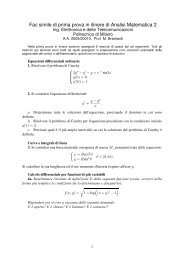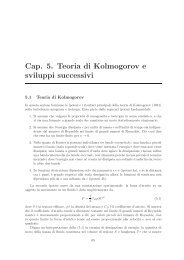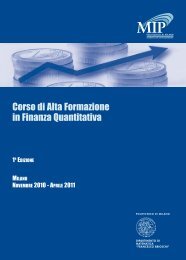Non-linear perturbations on spherical backgrounds (Formalism and ...
Non-linear perturbations on spherical backgrounds (Formalism and ...
Non-linear perturbations on spherical backgrounds (Formalism and ...
Create successful ePaper yourself
Turn your PDF publications into a flip-book with our unique Google optimized e-Paper software.
ackground c<strong>on</strong>necti<strong>on</strong>, or from (20) if we want it in terms of the <str<strong>on</strong>g>perturbati<strong>on</strong>s</str<strong>on</strong>g>of the metric. As there is no metric c<strong>on</strong>tracti<strong>on</strong> involved in the passagefrom the Riemman to the Ricci tensor, it is clear that∆ n [R µρ ] = ∆ n [R µνρ ν ]. (22)The resulting expressi<strong>on</strong> is symmetric in µ <strong>and</strong> ρ owing to the identityH αβ {k} h αβρ;µ = H αβ {k} h αβµ;ρ , (23)valid for any symmetric tensor H αβ such that H αβ {k} h β µ is also symmetricin α <strong>and</strong> µ.When c<strong>on</strong>sidering the Ricci scalar, <strong>on</strong>e has to take into account that thereis a metric c<strong>on</strong>tracti<strong>on</strong>,R = g αβ R αβ , (24)which will have a n<strong>on</strong>-zero c<strong>on</strong>tributi<strong>on</strong> when the perturbati<strong>on</strong> operator isapplied. Using formula (17), it is easy to compute the general perturbativeterm:( )n∑ n∆ n [R] = ∆ k [g αβ ]∆ n−k [Rkαβ ]. (25)k=0These formulas allow us to obtain the general perturbative term of theEinstein tensorG µν = R µν − 1 2 g µνg αβ R αβ , (26)where now formula (17) has to be applied twice, as the sec<strong>on</strong>d term of theequati<strong>on</strong> is the product of three objects. It is straightforward to rearrangelabels <strong>and</strong> write∆ n [G µν ] = ∆ n [R µν ]− 1 2n∑n∑k=0 j=kn!{n − j}h µν ∆ j−k [g αβ ]∆ k [R αβ ].k!(j − k)!(n − j)!(27)As explained in the introducti<strong>on</strong>, the full Einstein equati<strong>on</strong>s are equivalentto an infinite hierarchy of <str<strong>on</strong>g>linear</str<strong>on</strong>g> differential equati<strong>on</strong>s. In order to make thisexplicit, it suffices to take the Einstein equati<strong>on</strong>s <strong>and</strong> substitute the tensorsby their expansi<strong>on</strong>s in power series of ε:G µν = 8πT µν ⇔ ∆ n [G µν ] = 8π {n} T µν for all n. (28)We can separate the nth order perturbati<strong>on</strong> of the Einstein tensor into a partthat is <str<strong>on</strong>g>linear</str<strong>on</strong>g> in the nth perturbati<strong>on</strong> of the metric <strong>and</strong> a source that will be
composed of products of lower order <str<strong>on</strong>g>perturbati<strong>on</strong>s</str<strong>on</strong>g>. Then equati<strong>on</strong> (28) canbe written, for every n, in a schematic formL[ {n} h µν ] + {n} S µν [ {1} h, ..., {n − 1} h] = 8π {n} T µν , (29)where {n} S is the source term <strong>and</strong> L is a <str<strong>on</strong>g>linear</str<strong>on</strong>g> differential operator that <strong>on</strong>lydepends <strong>on</strong> the background geometry. If we define [8]{n}h µν ≡ {n} h µν − 1 2 g µν {n} h α α , (30)in general the operator can be written asL[ {n} h µν ] = 1 2 (g µν {n} h αβ R αβ − {n} h µν R + {n} h αµ;ν α + {n} h αν;µα(31)− g µν{n}h αβ ;αβ − {n} h µν;α α ).There is a special case which deserves particular attenti<strong>on</strong>. If the backgroundis a vacuum (T µν = 0), the background Ricci tensor will cancel outreducing the expressi<strong>on</strong> (31) toL[ {n} h µν ] = 1 2 ( {n} h αµ;ν α + {n} h αν;µ α − g µν{n}h αβ ;αβ − {n} h µν;α α ). (32)Now, we can interchange the order of the covariant derivatives in the firsttwo terms <strong>and</strong> impose the Lorenz gauge,{n}h µα;α = 0, (33)obtaining in this way the vacuum propagati<strong>on</strong> equati<strong>on</strong>,{n}h µν;α α + 2R αµβν{n}h αβ − 2 {n} S µν [ {1} h, ..., {n − 1} h] = −16π {n} T µν . (34)This is a wave equati<strong>on</strong> for the nth order perturbati<strong>on</strong> of the metric. Theinteracti<strong>on</strong> between the wave with the background is encoded in the sec<strong>on</strong>dterms, whereas the self-interacti<strong>on</strong> of the wave is given by the source {n} S µν .In order to close the system of equati<strong>on</strong>s (28), the matter evoluti<strong>on</strong> equati<strong>on</strong>sare necessary. These are equati<strong>on</strong>s for the matter fields ˜Φ(ε) <strong>and</strong> mustalso be <str<strong>on</strong>g>linear</str<strong>on</strong>g>ized.It is worth emphasizing that the combinatorial formulas for the <str<strong>on</strong>g>perturbati<strong>on</strong>s</str<strong>on</strong>g>of the curvature tensors at a general order that we have deduced in
this secti<strong>on</strong> are extremely useful for computati<strong>on</strong>al purposes. Essentially, theproblem of <str<strong>on</strong>g>perturbati<strong>on</strong>s</str<strong>on</strong>g> is reduced to that of listing the sorted partiti<strong>on</strong>sof a given number, which can be d<strong>on</strong>e very fast in any computer algebrasystem. This fact simply reflects the recursive differential origin of the perturbati<strong>on</strong>process. The formulas in this secti<strong>on</strong> have been implemented inthe free package xPert that will be explained in Secti<strong>on</strong> 5.3 Spherical background3.1 Gerlach <strong>and</strong> Sengupta notati<strong>on</strong>We will <strong>on</strong>ly c<strong>on</strong>sider <strong>spherical</strong>ly symmetric <strong>backgrounds</strong> <strong>and</strong> use the notati<strong>on</strong>introduced by GS [2]. We take the four-dimensi<strong>on</strong>al background manifoldM <strong>and</strong> write it as the product M 2 ×S 2 , where M 2 is a two-dimensi<strong>on</strong>alLorentzian manifold with boundary (this boundary will be associated withthe center of symmetry) <strong>and</strong> S 2 the two-sphere. We will use Greek indicesfor the four dimensi<strong>on</strong>al manifold <strong>and</strong> choose a coordinate system adaptedto this decompositi<strong>on</strong> x µ ≡ (x A , x a ). Capital Latin indices denote basis indices<strong>on</strong> the manifold M 2 , x A ≡ (x 0 , x 1 ), <strong>and</strong> lowercase Latin letters indicateindices <strong>on</strong> the two sphere, x a ≡ (x 2 , x 3 ).Any <strong>spherical</strong>ly symmetric metric <strong>and</strong> stress-energy tensor can be respectivelywritten as [2]g µν (x λ )dx µ dx ν = g AB (x D )dx A dx B + r 2 (x D ) γ ab (x d )dx a dx b ,t µν (x λ )dx µ dx ν = t AB (x D )dx A dx B + 1 2 r2 (x D ) Q(x D ) γ ab (x d )dx a dx b ,where g AB is the metric of the manifold M 2 , γ ab is the round metric of thesphere <strong>and</strong> r is a scalar defined <strong>on</strong> M 2 . The associated covariant derivativeof the round metric will be denoted by a semicol<strong>on</strong> (γ ab:c = 0).3.2 Spherical tensor harm<strong>on</strong>icsThe so-called RWZ tensor harm<strong>on</strong>ics [3, 4] provide bases for exp<strong>and</strong>ingscalars, vectors <strong>and</strong> symmetric rank-two tensors <strong>on</strong> the sphere. These harm<strong>on</strong>icshave a well-defined parity <strong>and</strong> are tangent to the sphere. They areclassified into two polarity families: under a parity transformati<strong>on</strong> the polar
<strong>and</strong> axial harm<strong>on</strong>ics change sign as (−1) l <strong>and</strong> (−1) l+1 , respectively, wherethe integer l is the corresp<strong>on</strong>ding harm<strong>on</strong>ic label.In order to face high-order perturbati<strong>on</strong> theory, we generalize the RWZharm<strong>on</strong>ics to any rank defining the polar harm<strong>on</strong>ic Zl m a 1 ...a s≡ (Ylm :a 1 ...a s) ST<strong>and</strong> the axial harm<strong>on</strong>ic Xl m a 1 ...a s≡ ε b (a1 Zl m ba 2 ...a s), where Ylm is the scalarharm<strong>on</strong>ic <strong>and</strong> the superscript ST st<strong>and</strong>s for the symmetric <strong>and</strong> trace-freepart. In this way, a complete basis for tensors of rank s is composed byZ m l a 1 ...a s, X m l a 1 ...a s<strong>and</strong> independent <str<strong>on</strong>g>linear</str<strong>on</strong>g> combinati<strong>on</strong>s of products betweenγ ab <strong>and</strong> ε ab with the basis of rank (s − 2).It is also neccesary to obtain a closed formula that expresses the productbetween any pair of RWZ generalized tensor harm<strong>on</strong>ics as <str<strong>on</strong>g>linear</str<strong>on</strong>g> combinati<strong>on</strong>of harm<strong>on</strong>ics with some Clebsch-Gordan-like coefficients [1].4 <str<strong>on</strong>g>N<strong>on</strong></str<strong>on</strong>g>-<strong>spherical</strong> <str<strong>on</strong>g>perturbati<strong>on</strong>s</str<strong>on</strong>g>We exp<strong>and</strong> the <str<strong>on</strong>g>perturbati<strong>on</strong>s</str<strong>on</strong>g> of the metric using the RWZ basis of harm<strong>on</strong>ics:{n}h µν ≡ ∑ {n}Hl,m( m l AB Zlm {n}H m l A Zl m b + {n} h m l A Xl m )b{n}Sym. Kl m r 2 γ ab Zl m + {n} G m l r 2 Zl m ab + {n} h m l Xl m .(35)abA similar decompositi<strong>on</strong> is d<strong>on</strong>e for the matter <str<strong>on</strong>g>perturbati<strong>on</strong>s</str<strong>on</strong>g> {n} T µν . Butthese <str<strong>on</strong>g>perturbati<strong>on</strong>s</str<strong>on</strong>g> have some gauge (n<strong>on</strong>physical) degrees of freedom. Thegauge freedom of the nth-order perturbati<strong>on</strong> of a background tensor is encodedin n vector fields [5]. We have demostrated that choosing vanishingharm<strong>on</strong>ics coefficients {n} H m l A,{n}G m l <strong>and</strong> {n} h m l fixes the gauge at any order.For the case n = 1 this gauge was introduced by Regge <strong>and</strong> Wheeler [3].Another way of removing these n<strong>on</strong>physical degrees of freedom is by usinggauge-invariant quantities. These invariants were introduced by M<strong>on</strong>crief [6]for Schwarzschild at <str<strong>on</strong>g>linear</str<strong>on</strong>g> order. GS [2] generalized them for any <strong>spherical</strong>lysymmetric background <strong>and</strong>, taking <str<strong>on</strong>g>linear</str<strong>on</strong>g> combinati<strong>on</strong>s of the matter <strong>and</strong>metric harm<strong>on</strong>ic coefficients (35), they c<strong>on</strong>structed seven polar ({ {1} Ψ}) <strong>and</strong>three axial ({ {1} ψ}) matter invariants, as well as six metric invariants, givenby the polar objects { {1} K m l AB, {1} K m l } <strong>and</strong> the axial vector {1} κ m l A. We havedesigned [7] an iterative method to generalize these objects up to any order,under certain restricti<strong>on</strong>s <strong>on</strong> the harm<strong>on</strong>ic labels.At sec<strong>on</strong>d-order, we have explicitly calculated [7] the invariants that arisefrom the same <str<strong>on</strong>g>linear</str<strong>on</strong>g> combinati<strong>on</strong>s that appear at first order, but supplementedwith some first-order quadratic terms. The sec<strong>on</strong>d-order Einstein
metric g[−µ, −ν]. There is a comm<strong>and</strong> Perturbati<strong>on</strong>[expr,n] which is ableto give the nth-order <str<strong>on</strong>g>perturbati<strong>on</strong>s</str<strong>on</strong>g> of any expressi<strong>on</strong> expr. It plays the roleof ∆, so it is defined with the properties of a derivative,Perturbati<strong>on</strong>[x +y,1] = Perturbati<strong>on</strong>[x,1] +Perturbati<strong>on</strong>[y,1], (38)Perturbati<strong>on</strong>[xy,1] = Perturbati<strong>on</strong>[x,1] y +x Perturbati<strong>on</strong>[y,1]. (39)We define its acti<strong>on</strong> <strong>on</strong> thenth perturbati<strong>on</strong> of the metric, <strong>and</strong>, as a particularcase, <strong>on</strong> the metric itself,Perturbati<strong>on</strong>[h[LI[n], −µ, −ν],1] = h[LI[n +1], −µ, −ν], (40)Perturbati<strong>on</strong>[g[−µ, −ν],1] = h[LI[1], −µ, −ν], (41)<strong>and</strong>, because of the relati<strong>on</strong> (7), we also definePerturbati<strong>on</strong>[g[µ, ν],1] = −g[µ, α] h[LI[1], −α, −β] g[β, ν]. (42)In this way, the internal procedure to calculate Perturbati<strong>on</strong>[expr,n] isthe following:• expr is written in terms of the metric g[−µ, −ν], its inverse g[µ, ν] <strong>and</strong>the nth order perturbati<strong>on</strong> of the metric h[LI[n], −µ, −ν]. This step isimmediate because the package xTensor knows the definiti<strong>on</strong> of all thecurvature tensors in terms of the metric <strong>and</strong> its inverse.• Perturbati<strong>on</strong>[expr,n] is exp<strong>and</strong>ed via Perturbati<strong>on</strong>[Perturbati<strong>on</strong>[expr,1],n −1]. From now <strong>on</strong> we <strong>on</strong>ly will deal with the most internalhead Perturbati<strong>on</strong>.• Perturbati<strong>on</strong> acts <strong>on</strong> expr making use of <str<strong>on</strong>g>linear</str<strong>on</strong>g>ity (38) <strong>and</strong> the Leibnitzrule (39).• Definiti<strong>on</strong>s (40-42) are applied.• If anyPerturbati<strong>on</strong> head remains, the process goes back to the sec<strong>on</strong>dstep of this chain.There is another comm<strong>and</strong> namedGeneralPerturbati<strong>on</strong>[expr,n] whichimplements the general expansi<strong>on</strong> formulas for the the inverse metric (10),the Christoffel symbols (15), the Riemann tensor (20), <strong>and</strong> the Ricci tensor<strong>and</strong> scalar. This general expansi<strong>on</strong>s are much faster than the recursive
procedures because <strong>on</strong>e <strong>on</strong>ly needs to calculate all the sorted partiti<strong>on</strong>s ofa certain integer number <strong>and</strong> this can be d<strong>on</strong>e very fast in any computeralgebra system.As an example, we present here the calculati<strong>on</strong> <strong>and</strong> can<strong>on</strong>icalizati<strong>on</strong> ofthe fifth order perturbati<strong>on</strong> of the Riemman tensor:DefManifoldM,1, 2, 3, 4,Μ,Ν,Ρ,Σ,Λ,Α,Β,Η,Τ,ΩDefMetric1, gΜ,Ν, CD,";", ""DefMetricPerturbati<strong>on</strong>g, h, ΕGeneralPerturbati<strong>on</strong>RiemannCD4Μ,Ν,Α,Β, 5 ToCan<strong>on</strong>ical Short8.54854 Sec<strong>on</strong>d5 h 3ΗΛ 1 1h ΝΛ;Α h ;Β ΜΗ 1554 h ΝΗ;Α2 h2ΗΛ h ΝΛ;Α4 1h Η;Β Μ 15 h 1ΗΛ h 2ΡΗ1Ρ2 1h ;Β ΜΗ 5 h 1ΗΛ 3h ΝΛ;Α h ΜΗ1 ;Β 1 1h ΝΡ;Α h ;Β 1ΜΛ 30 h ΗΡ h 1ΗΛ h 1ΡΣ 1 1h ΝΣ;Α h ;Β ΜΛ 2 1h ΝΡ;Α h ;Β ΜΛ 992 30 h 1ΒΗ 1h ΗΛ h 1ΛΡ 1 1h ΝΡ;Σ h ;Σ ΜΑ 15 h 1ΗΛ h Η30 h 1ΒΗ 1h ΗΛ h 1ΛΡ 1 1h ΡΣ;Μ h ;Σ ΝΑ 30 h 1ΒΗ 1h ΗΛ h 1ΛΡ 1 1h ΜΣ;Ρ h ;Σ ΝΑ 30 h 1ΒΗ 1h ΗΛ h 1ΛΡ 1 1 ;Σh ΜΡ;Σ h ΝΑIn fact, this expressi<strong>on</strong> is <strong>on</strong>ly a shortened representati<strong>on</strong> of the resultbecause means that there are another 992 terms that have not beendisplayed.In order to give an idea of the high efficiency of this package, the followingfigure displays the can<strong>on</strong>icalizati<strong>on</strong> times for the <str<strong>on</strong>g>perturbati<strong>on</strong>s</str<strong>on</strong>g> of the Riemanntensor with a small PC. The horiz<strong>on</strong>tal axis represents the perturbativeorder whereas the vertical axis describes in a logarithmic scale the total numberof terms of the perturbati<strong>on</strong> of the Riemann tensor, which appears inblue, <strong>and</strong> the time spent to calculate <strong>and</strong> can<strong>on</strong>icalize the expressi<strong>on</strong>, printedin red.10000Hour100Minute1Sec<strong>on</strong>d2 4 6 8 10
5.2 Harm<strong>on</strong>icsThe package Harm<strong>on</strong>ics implements different kinds of tensor <strong>spherical</strong>harm<strong>on</strong>ics [10]. For a descripti<strong>on</strong> of the c<strong>on</strong>venti<strong>on</strong>s used in this package,see reference [1]. The comm<strong>and</strong>s PureOrbital[j, l, m][a,b,...] <strong>and</strong>PureSpin[j, ±1, m][a,b,...] provide, respectively, any pure-orbital orpure-spin harm<strong>on</strong>ics, both in abstract form or giving their comp<strong>on</strong>ents inany coordinate or n<strong>on</strong>coordinate basis. The generalized RWZ harm<strong>on</strong>icsZ[LI[l],LI[m],a,b, ...] <strong>and</strong> X[LI[l],LI[m],a,b, ...] have also been defined, incorporatingall their symmetries <strong>and</strong> properties [1]. The product formula hasalso been included by a rule named productRule.As an example of the use of this package, we present here the expansi<strong>on</strong>of the product between two tensorial <strong>spherical</strong> harm<strong>on</strong>ics into a <str<strong>on</strong>g>linear</str<strong>on</strong>g> combinati<strong>on</strong>of harm<strong>on</strong>ics, in <strong>spherical</strong> coordinates (θ, φ). The harm<strong>on</strong>ic labels l<strong>and</strong> m appear in black, while we show in red the coordinate indices with thenotati<strong>on</strong> (2, 3) ≡ (θ, φ).DefManifoldS2,2, 3,a, b, c, d, e, f, wDefMetric1, gammaa,b, cd,":", "D", PrintAs "Γ"RicciScalarcd :⩵ 2DefChart<strong>spherical</strong>, S2,Θ,Φ, BasisColorRedXLI7, LI2,2, <strong>spherical</strong>,3, <strong>spherical</strong>ZLI4, LI1,2, <strong>spherical</strong>,2, <strong>spherical</strong>,3, <strong>spherical</strong>72X 3 412 Z 223%. productRule Simplify0.736047 Sec<strong>on</strong>d14 CscΘ2,7,2 E 3,4,1;42,7,2X 41 2,7,23 E 3,4,1;6SinΘ X 2232X 61 2,7,23 E 3,4,1;82,7,2X 81 2,7,23 E 3,4,1;10X 101 2,7,23 4 E 3,4,1;551SinΘ X 3 2232 714 E 3 913,4,1;7 4 E 3,4,1;9 SinΘ X 3 1112232 4 E 3,4,1;11 SinΘ X 3 2232 2,7,2E 3,4,1;3 Z 31 2,7,23 E 3,4,1;5 Z 51 2,7,23 E 3,4,1;7 Z 71 2,7,23 E 3,4,1;9 Z 91 2,7,23 E 3,4,1;11 Z 111 3 2,7,2614 E 3,4,1;6 SinΘ Z 3 2,7,2812232 4 E 3,4,1;8 SinΘ Z 3 2,7,22232 4 E 3,4,1;10 SinΘ Z 2232%. coeffERule Harm<strong>on</strong>icComp<strong>on</strong>ent0.64404 Sec<strong>on</strong>d2,7,2101 3 1 8505 7 131072 Π Φ 338 1351 Cos2 Θ 990 Cos4 Θ 1001 Cos6 Θ Sin2 Θ 2
The time spent by the computer to make the computati<strong>on</strong> between eachinput <strong>and</strong> output is also shown above.5.3 xPertGSThe package xPertGS needs the previous two packages <strong>and</strong> has threesecti<strong>on</strong>s:• Spherical background. The reduced manifold M 2 is defined with itsmetric g[-A,-B] (<strong>and</strong> corresp<strong>on</strong>ding derivative CD[-A]). The scalarfield r[] is also defined. The manifold M 4 is c<strong>on</strong>structed as a productof M 2 <strong>and</strong> S 2 ; all tensors <strong>on</strong> M 4 can be block-decomposed in theirrespective parts <strong>on</strong> those submanifolds.• First order. First-order <str<strong>on</strong>g>perturbati<strong>on</strong>s</str<strong>on</strong>g> are defined <strong>and</strong> their gauge invariantsc<strong>on</strong>structed. The evoluti<strong>on</strong> equati<strong>on</strong>s for these invariants arealso computed. The energy-momentum c<strong>on</strong>servati<strong>on</strong> equati<strong>on</strong>s are calculated<strong>and</strong>, making use of the first-order Einstein equati<strong>on</strong>s, it ischecked that they are trivially zero. The total executi<strong>on</strong> time of thispart is of the order of two minutes in a PC.• Sec<strong>on</strong>d order. The scheme is the same as at first order. Sec<strong>on</strong>d-order<str<strong>on</strong>g>perturbati<strong>on</strong>s</str<strong>on</strong>g> are defined <strong>and</strong> their equati<strong>on</strong>s computed <strong>and</strong> manipulatedin order to simplify them as much as possible. The energymomentumc<strong>on</strong>servati<strong>on</strong> equati<strong>on</strong>s are also computed <strong>and</strong> the Bianchiidentity verified. The total executi<strong>on</strong> time of this part is of the orderof two hours.6 C<strong>on</strong>clusi<strong>on</strong>sIn this work, we have summarized the formalism that has been presentedrecently in Refs. [1] <strong>and</strong> [7] in order to deal with high-order <str<strong>on</strong>g>perturbati<strong>on</strong>s</str<strong>on</strong>g> of<strong>spherical</strong> <strong>backgrounds</strong> in a gauge-invariant way. We have focused <strong>on</strong> somespecific features of our formalism to make them more transparent.On the <strong>on</strong>e h<strong>and</strong> we have given the detailed derivati<strong>on</strong> of the closedformulas for the nth order perturbati<strong>on</strong> of every curvature tensor of interest.In particular, restricting the background to a vacuum, we have deduced thepropagati<strong>on</strong> equati<strong>on</strong> of the nth order perturbati<strong>on</strong> of the metric. These
ecursive formulas are important from a computati<strong>on</strong>al point of view becausethey allow to reduce the problem of calculating the nth order perturbati<strong>on</strong>of any curvature tensor essentially to that of listing all the sorted partiti<strong>on</strong>sof the number n.On the other h<strong>and</strong>, we have explained both the internal structure <strong>and</strong> theexternal use of the Mathematica packages which we have developed during ourinvestigati<strong>on</strong>. Each of the packages is designed for <strong>on</strong>e part of the problem.More precisely, xPert deals with the <str<strong>on</strong>g>perturbati<strong>on</strong>s</str<strong>on</strong>g> of all the tensors thatappear in our analysis without imposing any symmetry in the background.Harm<strong>on</strong>ics implements some structures defined in a two-sphere, in particularit incorporates different definiti<strong>on</strong>s of <strong>spherical</strong> tensor harm<strong>on</strong>ics that havebeen used in several applicati<strong>on</strong>s. Finally, xPertGS combines the last twopackages in order to compute sec<strong>on</strong>d-order <str<strong>on</strong>g>perturbati<strong>on</strong>s</str<strong>on</strong>g> <strong>on</strong> a <strong>spherical</strong>lysymmetric background.AcknowledgmentsD.B. acknowledges financial support from the FPI program of the Regi<strong>on</strong>alGovernment of Madrid. J.M.M.-G. acknowledges the financial aid providedby the I3P framework of CSIC <strong>and</strong> the European Social Fund. This workwas supported by the Spanish MEC Project No. FIS2005-05736-C03-02.References[1] D. Brizuela, J. M. Martín-García <strong>and</strong> G. A. Mena Marugán, Phys. Rev.D 74 044039 (2006).[2] U. H. Gerlach <strong>and</strong> U. K. Sengupta, Phys. Rev. D 19 2268 (1979).[3] T. Regge <strong>and</strong> J. A. Wheeler, Phys. Rev. 108 1063 (1957).[4] F. J. Zerilli, Phys. Rev. Lett. 24 737 (1970).[5] S. S<strong>on</strong>ego <strong>and</strong> M. Bruni, Commun. Math. Phys. 193 209 (1998).[6] V. M<strong>on</strong>crief, Annals of Physics 88 323 (1973).[7] D. Brizuela, J. M. Martín-García <strong>and</strong> G. A. Mena Marugán, Phys. Rev.D 76 024004 (2007).
[8] C. W. Misner, K. S. Thorne <strong>and</strong> J. A. Wheeler, Gravitati<strong>on</strong> (Freeman,New York, 1973).[9] J. M. Martín-García, “xTensor, a free abstract tensor manipulator forMathematica”, http://metric.iem.csic.es/Martin-Garcia/xAct/.[10] K. S. Thorne, Rev. Mod. Phys. 52 299 (1980).




